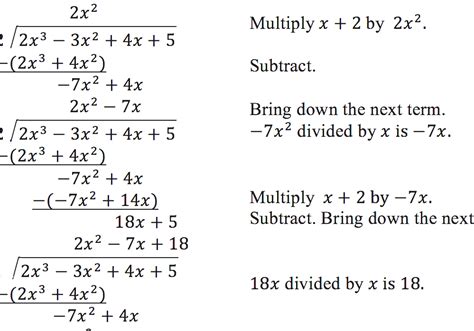Introduction

Polynomial long division is a fundamental mathematical technique used to divide one polynomial by another. It plays a crucial role in various mathematical applications, including factorization, solving equations, and calculus. By mastering this skill, you will gain a deeper understanding of polynomial operations and enhance your problem-solving abilities.
Step-by-Step Process
Step 1: Set Up the Division Problem
Write the dividend (the polynomial being divided) outside the division bracket and the divisor (the polynomial that divides) inside the bracket.
Step 2: Divide the First Term of the Dividend
Divide the first term of the dividend by the first term of the divisor. Write the result above the division bracket, directly above the first term of the dividend.
Step 3: Multiply the Divisor
Multiply the divisor by the result obtained in Step 2. Write the product under the dividend, aligning the corresponding terms.
Step 4: Subtract and Bring Down
Subtract the product obtained in Step 3 from the dividend. Bring down the next term of the dividend.
Step 5: Repeat Steps 2-4
Repeat Steps 2 to 4 until there are no more terms in the dividend to bring down.
Step 6: Interpret the Result
The quotient obtained above the bracket is the polynomial that divides the dividend. The remainder (if any) is the polynomial that cannot be divided by the divisor.
Practice Problems
Problem 1:
Divide (3x^3 – 5x^2 + 2x – 1) by (x – 1).
Problem 2:
Divide (x^4 – 2x^3 + x^2 – 3x + 2) by (x – 2).
Problem 3:
Divide (2x^5 – 3x^4 + 4x^3 – 5x^2 + 6x – 7) by (2x – 1).
Common Mistakes to Avoid
- Incorrect Sign: Ensure the signs of the terms in the quotient and remainder are correct.
- Division by Zero: Never divide by zero.
- Improper Alignment: Align the corresponding terms of the dividend and product correctly.
- Negligence in Subtraction: Subtract the product obtained in Step 3 from the dividend thoroughly.
- Premature Division: Avoid dividing the dividend by the divisor before completing the subtraction.
Frequently Asked Questions (FAQs)
1. When should I use long division of polynomials?
Use long division when you need to divide a polynomial by another polynomial with a lower degree.
2. What is the significance of the remainder?
The remainder represents the polynomial that cannot be divided by the divisor.
3. Can I check my answer using synthetic division?
Yes, you can use synthetic division to verify your result.
4. How does polynomial long division help in factorization?
By using long division, you can factor out a polynomial that divides another polynomial, providing valuable insights into its structure.
Applications of Polynomial Long Division
Polynomial long division finds applications in various fields, including:
- Algebra: Factorization, solving equations, and manipulating polynomials.
- Calculus: Finding derivatives and integrals of rational functions.
- Number Theory: Determining divisibility and finding greatest common divisors.
Conclusion
Mastering polynomial long division is an essential step in enhancing your mathematical abilities. By practicing the techniques and avoiding common mistakes, you can tackle complex polynomial operations with confidence. Remember, the key to success lies in diligent practice and a thorough understanding of the underlying principles.
